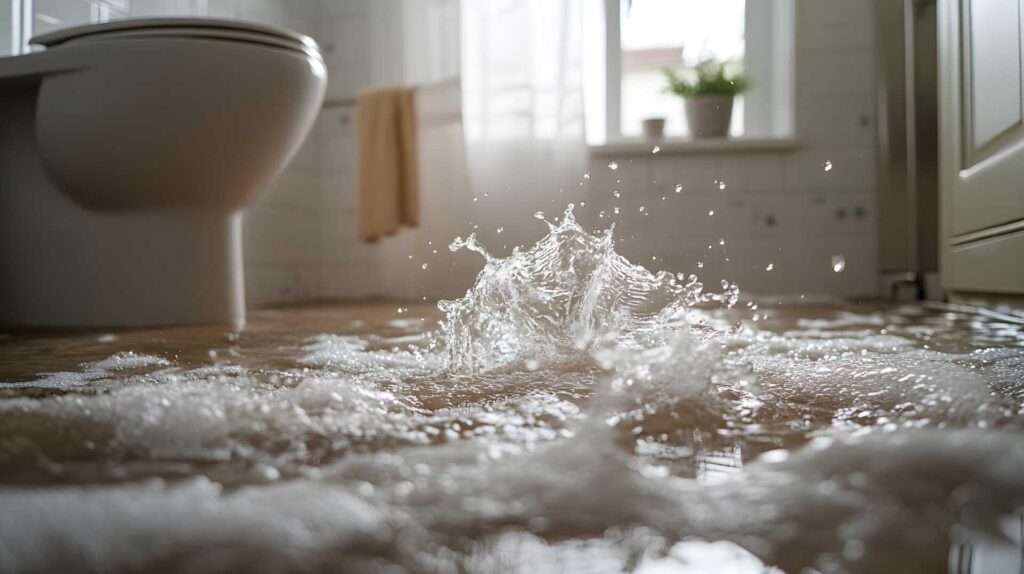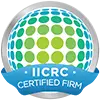
Contents
A sewage backup can feel like a catastrophic disaster, but with the right approach, you can tackle the situation effectively. First, evaluating the situation and ensuring your safety is essential. You’ll need to gather specific cleaning supplies and protective gear before diving into the cleanup process. Understanding the steps involved can make all the difference in restoring your space and preventing future incidents. Are you prepared to handle the aftermath?
Key Takeaways
- Assess the situation thoroughly, identify the source of the backup, and ensure proper safety precautions are in place before beginning cleanup.
- Wear protective gear, including gloves, masks, and waterproof boots, to safeguard yourself from contaminants during the cleaning process.
- Use a wet/dry vacuum to efficiently remove excess water and follow up with a disinfectant solution to sanitize affected surfaces.
- Inspect for mold growth in hidden areas and take immediate action to remove contaminated materials and prevent future mold development.
- Implement preventative measures, such as regular drain maintenance and installing a backwater valve, to reduce the risk of future sewage backups.
Assess the Situation and Ensure Safety
Before you start any cleanup, assessing the situation and ensuring your safety is crucial.
Begin by identifying the source of the sewage backup and determining the extent of the contamination. This situation assessment will help you understand the level of risk involved.
Make sure that you wear protective gear, such as gloves, masks, and waterproof boots, to adhere to safety protocols. If the sewage is extensive or poses health risks, consider evacuating the area and contacting professionals.
Check for electrical hazards and turn off power to the affected areas if necessary. Proper ventilation is key; open windows and doors to minimize exposure to harmful fumes.
Once you’ve evaluated the risks and taken necessary precautions, you’ll be better equipped to proceed with a safe and effective cleanup.
Prioritizing safety protects you and fosters a sense of community responsibility in tackling such challenging situations.
Gather Necessary Cleaning Supplies
Before you start cleaning a sewage backup, you’ll need to gather essential cleaning tools and protective gear.
Make certain you have items like gloves, masks, buckets, and disinfectants ready to minimize health risks.
Having the right supplies on hand will streamline the process and enhance safety.
Essential Cleaning Tools
Having the right cleaning tools is essential when tackling a sewage backup.
You need effective cleaning equipment and sanitation supplies to ensure a thorough job.
Here’s a list of items you should gather before you start:
- Heavy-duty gloves for protection
- A wet/dry vacuum for efficient water removal
- A mop and bucket for cleaning surfaces
- Disinfectant solution to sanitize affected areas
- Rags or towels for drying and wiping
Protective Gear Needed
Cleaning a sewage backup requires more than just the right tools; protective gear is essential for your safety.
To comply with safety regulations and follow proper cleaning protocols, you’ll need durable gloves, ideally made of rubber or nitrile, to shield your hands from contaminants.
Wear waterproof boots to prevent exposure to hazardous materials and ensure stability on slippery surfaces.
A face mask or respirator protects you from harmful fumes and bacteria.
Additionally, goggles will safeguard your eyes from splashes and debris.
Don’t forget protective clothing, such as coveralls, to minimize skin exposure.
Wear Protective Gear
When handling a sewage backup, wearing protective gear is vital to ensuring your safety.
Start with essential protective clothing, such as gloves and coveralls, to shield your skin from contaminants.
Selecting proper footwear and face protection will further minimize your risk of exposure to hazardous materials.
Essential Protective Clothing
Three essential pieces of protective clothing are crucial for anyone tackling sewage backup cleaning.
First, you should wear protective gloves to shield your hands from harmful bacteria and contaminants.
Next, safety goggles will protect your eyes from splashes and debris, ensuring you can see clearly while working.
Finally, a waterproof coverall or suit will keep your skin safe from exposure to hazardous materials.
Here are additional protective items to take into account:
- N95 respirator mask for airborne particles
- Heavy-duty rubber boots for foot protection
- Disposable shoe covers for hygiene
Proper Footwear Selection
Selecting the right footwear is essential for anyone involved in sewage backup cleaning. You need to prioritize safety footwear that can withstand hazardous conditions.
Opt for waterproof boots made from durable materials, as they’ll protect your feet from exposure to harmful contaminants. Ensure your boots have slip-resistant soles to prevent accidents on wet surfaces, which can be particularly treacherous during cleanup.
Additionally, consider boots with reinforced toe caps for extra protection against heavy objects that may be present.
Remember, the right footwear safeguards your health and enhances your confidence while tackling this challenging task.
Face Protection Importance
Protecting your face during sewage backup cleaning is crucial to safeguarding your health. Contaminated water can expose you to harmful pathogens, so wearing appropriate protective gear is non-negotiable. A face mask and eye protection are essential to shield you from splashes and airborne particles.
Here are some key items to evaluate:
- N95 face mask: Filters out harmful particles.
- Safety goggles: Protects your eyes from contaminants.
- Face shield: Offers extra protection against sprays.
- Rubber gloves: Keeps your hands safe while handling materials.
- Protective coveralls: Minimizes skin exposure to hazardous substances.
Remove Standing Water
To effectively remove standing water after a sewage backup, start by using a wet/dry vacuum or a submersible pump to extract as much liquid as possible. These tools are essential in your standing water removal efforts, enabling you to act quickly and prevent further damage.
Make sure to check the power source and verify it’s safe to operate in a flooded area.
Once you’ve removed most of the water, consider employing additional water extraction techniques, like mopping or using absorbent materials, to tackle any remaining moisture.
If the water is deep, you might need to alternate between pumping and vacuuming to keep the process efficient.
Always prioritize your safety; wear appropriate protective gear while working in contaminated areas.
Clean and Disinfect Affected Areas
After successfully removing standing water, the focus shifts to cleaning and disinfecting the affected areas to eliminate harmful pathogens and prevent health risks.
Start by wearing protective gear, including gloves and masks, to ensure your safety as you work. Use a mixture of water and a suitable disinfectant to thoroughly disinfect surfaces. It’s essential to sanitize equipment used during the cleanup process to avoid cross-contamination.
- Clean all surfaces with a scrub brush to remove dirt and debris.
- Use a disinfectant that’s effective against bacteria and viruses.
- Pay special attention to high-touch areas like doorknobs and light switches.
- Allow disinfectants to sit for the recommended time to ensure effectiveness.
- Rinse surfaces after disinfecting to remove any residue.
Dispose of Contaminated Materials Properly
Once you’ve cleaned and disinfected the area, proper disposal of contaminated materials becomes vital to prevent further contamination and health risks.
Start by identifying all contaminated waste, including items like carpets, clothing, and any porous materials that can’t be effectively cleaned. Seal these items in heavy-duty plastic bags to contain any pathogens and odors.
Next, check local regulations regarding the safe disposal of contaminated waste, as many areas have specific guidelines for hazardous materials. It’s important to follow these regulations to ensure you’re disposing of waste responsibly.
If possible, contact a professional waste disposal service experienced in handling biohazardous materials. They can confirm that your contaminated waste is treated and disposed of safely and appropriately, minimizing any risk to you and your community.
Proper disposal isn’t just about cleanliness; it’s about protecting your health and the well-being of those around you.
Dry the Area Thoroughly
Thoroughly drying the area is essential to prevent mold growth and further damage. Start by removing any standing water using pumps or wet vacuums.
Once the bulk of the moisture is gone, set up a dehumidifier to absorb humidity from the air. This dehumidifier usage will notably accelerate the drying process.
Additionally, enhance air circulation by opening windows and using fans. This helps with drying and minimizes odors.
Here are some tips to ensure effective drying:
- Use a wet/dry vacuum for any remaining water.
- Place dehumidifiers in multiple locations for better coverage.
- Keep windows open for fresh air, weather permitting.
- Utilize oscillating fans to distribute air evenly.
- Regularly check humidity levels to gauge progress.
Check for Mold Growth
As you assess the area for potential mold growth, it’s vital to act quickly since mold can develop within 24 to 48 hours in damp environments.
Start by inspecting hidden corners, behind appliances, and under flooring, where moisture may linger. Look for discoloration or a musty smell, both indicators of mold presence.
If you find mold, prioritize safety by wearing protective gear, including gloves and masks. Remove contaminated materials, such as drywall or carpeting, to prevent further spread.
Remember, mold can pose serious health risks, particularly for those with respiratory issues or weakened immune systems.
Implementing mold prevention strategies is significant. Confirm proper ventilation in affected areas and maintain low humidity levels. Use dehumidifiers if necessary.
Taking these steps protects your health and fosters a sense of security in your living environment, helping you feel more at home.
Prevent Future Sewage Backups
Addressing mold growth is just one part of maintaining a healthy living environment; preventing future sewage backups is equally important.
To safeguard your home, commit to regular maintenance and schedule plumbing inspections. These proactive measures can help you identify potential issues before they escalate into costly repairs.
Here are some essential tips to prevent future sewage backups:
- Know your plumbing system: Understand how your pipes function and where potential blockages may occur.
- Avoid flushing inappropriate items: Never flush wipes, feminine products, or grease down the toilet.
- Maintain your yard: Keep tree roots away from sewer lines by planting trees carefully.
- Install a backwater valve: This device can prevent sewage from flowing back into your home.
- Schedule regular maintenance: Regularly inspect and clean your drains to ensure they’re functioning properly.
Recap
In the battle against sewage backups, your safety and health come first, yet swift action is essential to minimize damage. By combining thorough cleaning with proactive prevention, you can turn a distressing situation into a learning opportunity. Don’t just react to the mess; arm yourself with knowledge to avoid future incidents. With the right tools and strategies, you can reclaim your space and ensure a cleaner, safer environment for everyone.
Recent Posts
Swift Solutions for Unwanted Waste Woes
Imagine a foul odor creeping through your home, signaling a sewage backup that disrupts your
Why Effective Cleanup Matters for Homeowners
As a homeowner, effective cleanup is essential for protecting your property and maintaining its value.
Top Methods for Home Waste Cleanup
Like a well-prepared firefighter tackling a blaze, you must approach home waste cleanup with strategy




